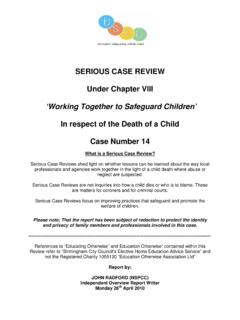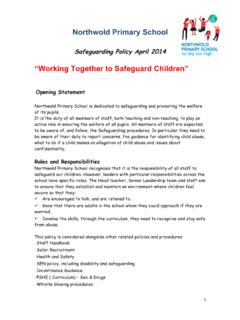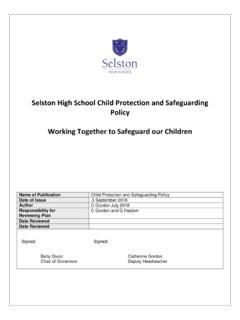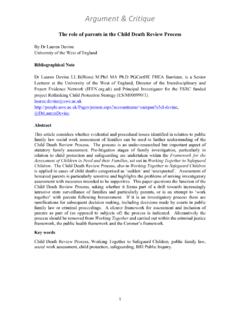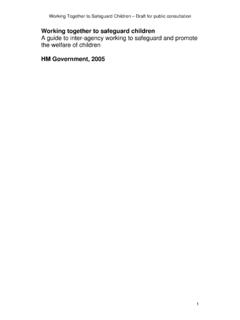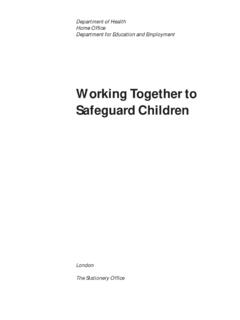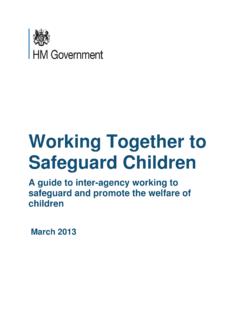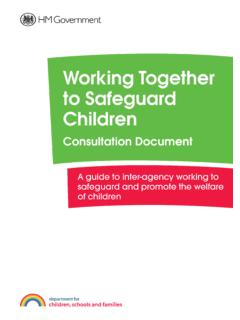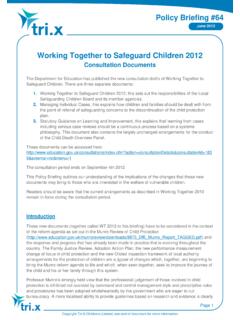Transcription of Working Together to Safeguard Children, July 2018
1 Page 1 Working Together to Safeguard Children, July 2018 Katie Rigg & Jane Foster | 12 July 2018 Last week, the Department for Education (DfE) published a long-awaited update to Working Together to Safeguard Children (July 2018) (WTSC), which comes into force immediately, replacing Working Together to Safeguard Children (2015).This guidance sets out additional safeguarding responsibilities for organisations Working with children and introduces a new model for inter-agency Working , which will see the disappearance of Local Safeguarding Children s Boards (LSCBs) and the introduction of three local Safeguarding Partners . Meanwhile, the Equality and Human Rights Commission (EHRC) has published new guidance for tackling prejudice-based bullying. Although the guidance is aimed at schools, its principles are applicable to all organisations Working with children. This article highlights the key changes to WTSC and the main features of the EHRC Guidance.
2 It also sets out some of the steps that organisations can take in response to these developments. Working Together to Safeguard Children (July 2018) Voice of the Child WTSC includes a greater emphasis on the voice of the child, which now includes a list of requests that children made when asked what they wanted from an effective safeguarding system. These include: vigilance: to have adults notice when things are troubling them understanding and action: to understand what is happening; to be heard and understood; and to have that understanding acted upon stability: to be able to develop an ongoing stable relationship of trust with those helping them respect: to be treated with the expectation that they are competent rather than not information and engagement: to be informed about and involved in procedures, decisions, concerns and plans WTSC includes a list of requests that children made when asked what they wanted from an effective safeguarding system If you require further information on anything covered in this briefing, please contact Katie Rigg.
3 +44(0)203 375 7607), Jane Foster ; +44(0)203 375 7000) or your usual contact at the firm on 020 3375 7000. This publication is a general summary of the law. It should not replace legal advice tailored to your specific circumstances. Farrer & Co LLP, July 2018 Page 2 explanation: to be informed of the outcome of assessments and decisions and reasons when their views have not met with a positive response support: to be provided with support in their own right as well as a member of their family advocacy: to be provided with advocacy to assist them in putting forward their views protection: to be protected against all forms of abuse and discrimination and the right to special protection and help if a refugee WTSC makes it clear that these requests should guide the behaviour of all practitioners Working with children. WTSC also now requires practitioners to put in place special provision to support dialogue with children who have communication difficulties, unaccompanied children, refugees and those children who are victims of modern slavery and/or trafficking.
4 Organisations Safeguarding Duties There is an increased focus on the safeguarding duties of organisations , which are now mentioned alongside agencies throughout WTSC. Chapter Two of WTSC sets out the safeguarding duties of organisations Working with children. The list of organisations has been expanded. In addition to statutory agencies, schools and colleges, voluntary, faith-based, and private sectors, WTSC now also refers: to Sports Clubs/Organisations - these are required to have in place the safeguarding arrangements described in Chapter Two of the Guidance (set out below). WTSC now requires all National Governing Bodies of Sport that receive funding from either Sport England or UK Sport to aim to meet the, Standards for Safeguarding and Protection Children in Sport, issued by the Child Protection in Sport Unit. to Charity and Social Enterprise Organisations previous references to voluntary sector have been replaced by voluntary, charity, social enterprise (VCSE), which are required to have appropriate arrangements in place to Safeguard children from harm.
5 WTSC now includes specific requirements on charity trustees who are responsible for ensuring that those benefitting from, or Working with, their charity, are not harmed in any way through contact with it . WTSC also directs charities to the Charity Commission s Strategy for dealing Page 3 with safeguarding issues in charities, and requires charities to follow Charity Commission guidance on charity compliance. WTSC also includes additional requirements for organisations that were referred to in the previous version of the guidance. For example, Early Years providers now need to ensure that they are alert to any issues of concern in the child s life and that they implement a policy and procedures to Safeguard children. This policy must include an explanation of the action to be taken when there are safeguarding concerns about a child and in the event of an allegation being made against a member of staff.
6 It must also cover the use of mobile phones and cameras in the setting, and training must enable staff to understand their safeguarding policy and procedures. In addition to these specific requirements, all organisations referred to in Chapter Two are required to comply with the general responsibilities set out in this Chapter, which are primarily set out at Paragraphs 3 to 9. As with the previous version of the guidance, organisations are required to have in place arrangements that reflect the importance of safeguarding and promoting the welfare of children. The list of examples that fall within this overarching responsibility has been expanded to include: The senior board level that takes leadership responsibility for the safeguarding arrangements must now have the required knowledge, skills and expertise or be sufficiently qualified and experienced to undertake the role; Clear escalation policies for staff to follow when their child safeguarding concerns are not being addressed within their organisation or by other agencies; Ongoing safe Working practices; and Creating a culture, of safety, equality and protection within the services they provide.
7 Multi-Agency Working Local Safeguarding Partners In May 2016 Alan Wood s review of the role and functions of LSCBs was published. This review proposed a new multi-agency child safeguarding model that was designed to ensure collective accountability across local authorities, the police and health. The review s key recommendations are now included in the Children and Social Work Act 2017, and in WTSC. What are the key changes? Under the new model LSCBs will be disbanded and replaced with a partnership system whereby three local Safeguarding Partners will have a shared and equal duty to make arrangements to work with each other and with the relevant agencies that they select, to Safeguard and promote the welfare of all children in their local area, and to act as a strategic leadership group in supporting and engaging others. Page 4 The new model places greater emphasis on partnership Working across organisations and agencies, with WTSC repeatedly emphasizing the risks to children and inefficiencies that can be caused by fragmented provision of services.
8 It urges Safeguarding Partners and other local organisations to develop processes that facilitate action beyond usual institutional constraints, and to share and co-own the vision for how to achieve improved outcomes for vulnerable children. When will these changes take place? The DfE has published transitional guidance for LSCBs, local authorities, safeguarding partners, child death review partners and the Child Safeguarding Practice Review Panel, which provides guidance on how local authorities can transition from the current model to the new model. This guidance makes it clear that this transition must be completed by 29 September 2019. Who are the local Safeguarding Partners and Relevant Agencies? The three local Safeguarding Partners the Local Authority; a clinical commissioning group for an area, any part of which falls within the local authority; and the chief officer of police for a police area, any part of which falls within the local authority area.
9 The geographical boundaries for the new arrangements are based on local authority areas. Every local authority, clinical commissioning group and police force must be covered by a local safeguarding arrangement. Relevant agencies Relevant agencies are those organisations and agencies whose involvement the Safeguarding Partners consider is required to Safeguard and promote the welfare of local children. For local arrangements to be effective, they should engage organisations and agencies that can work in a collaborative way to provide targeted support to children and families as appropriate. For the purposes of the underlying Regulations,1 relevant agencies include (but are not limited to): proprietors of independent schools2 and Academy schools3 including 16-19 Academies4 and alternative provision Academies;5 WTSC urges Safeguarding Partners and other local organisations to develop processes that facilitate action beyond usual institutional constraints.
10 1 The Child Safeguarding Practice Review and Relevant Agency (England) Regulations 2018 2 registered under section 95(1) of the Education and Skills Act 2008(4) 3 within the meaning given by section 1A of the Academies Act 2010(1) 4 within the meaning given by section 1B of the Academies Act 2010 5 within the meaning given by section 1C of the Academies Act 2010 Page 5 the governing body of a maintained school6 and nursery school;7 pupil referral units;8 charities;9 religious organisations;10 and any person or body involved in the provision, supervision or oversight of sport or leisure. WTSC allows any national or local organisation to be named as a relevant agency in the local safeguarding procedures (see below), regardless of whether they constitute a relevant agency for the purposes of these underlying Regulations. How will the new child safeguarding model work in practice?




